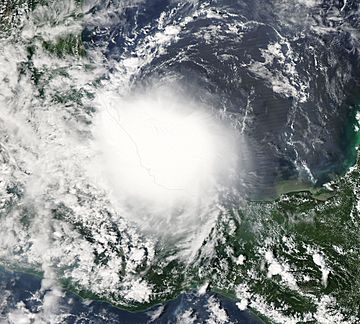Hurricane Lorenzo (2007) facts for kids
| Category 1 hurricane (SSHWS/NWS) | |

Tropical Storm Lorenzo quickly strengthening off the Mexican coast.
|
|
| Formed | September 25, 2007 |
|---|---|
| Dissipated | September 28, 2007 |
| Highest winds | 1-minute sustained: 80 mph (130 km/h) |
| Lowest pressure | 990 mbar (hPa); 29.23 inHg |
| Fatalities | 5 direct |
| Areas affected | Central Mexico |
| Part of the 2007 Atlantic hurricane season | |
Hurricane Lorenzo was a powerful storm that formed in the Atlantic Ocean in 2007. It was the twelfth named storm and the fourth hurricane of that year's Atlantic hurricane season. This hurricane quickly grew strong in the Bay of Campeche, which is off the east coast of Mexico. It made landfall in central Mexico on September 28 as a Category 1 hurricane.
Contents
How Hurricane Lorenzo Formed
On September 21, 2007, an area of convection (which means rising air that creates clouds and storms) started in the western Caribbean Sea. This was linked to a trough of low pressure. Over time, more convection formed, and a large area of low pressure developed on September 22. This system moved northwest towards the Yucatán Peninsula.
Lorenzo's Path and Growth
By September 23, the low-pressure area moved over the Yucatan Peninsula. It caused thunderstorms from the southern Gulf of Mexico to the northwestern Caribbean Sea. For a few days, this large low-pressure area moved slowly over the southwestern Gulf of Mexico. However, strong wind shear (winds blowing in different directions at different heights) stopped it from getting stronger.
On September 25, the upper-level winds became weaker. This made conditions better for a tropical cyclone to form. That morning, satellite images showed that a tropical depression might be forming. It was about 180 miles (290 km) east of Tampico, Tamaulipas, Mexico.
Becoming a Hurricane
Later on September 25, a United States Air Force Hurricane Hunter aircraft flew into the system. They found that the low-pressure area had indeed become a tropical depression. The depression then moved slowly to the south and southwest into the Bay of Campeche.
On September 26, the storm's convection increased, and it got closer to becoming a tropical storm. Early on September 27, the Mexican Government issued a tropical storm watch for parts of its Gulf Coast. This was because the depression was expected to strengthen.
The storm quickly grew stronger on September 27. Around midday, the depression officially became Tropical Storm Lorenzo. It continued to strengthen rapidly that afternoon. In less than seven hours after being named, Lorenzo became a full hurricane. Lorenzo made landfall in central Mexico, south-southwest of Tuxpan. It hit as a Category 1 hurricane with winds of 80 mph (130 km/h). Lorenzo lost strength and disappeared later that afternoon.
Getting Ready for Hurricane Lorenzo
People in Mexico prepared for Hurricane Lorenzo as it approached. On September 26, a tropical storm warning was issued for the central Mexican Gulf Coast. As Lorenzo quickly became stronger, this warning was upgraded to a hurricane warning. Officials in Mexico's Civilian Protection agency declared a "red alert" for much of the state of Veracruz. This meant there was a high danger.
Evacuations and Safety Measures
At first, no evacuations were ordered immediately. However, shelters were set up in Veracruz, and officials canceled classes at all local schools. Because the storm developed so fast, officials quickly evacuated over 100,000 people just before Lorenzo hit. They used bullhorns on the streets to warn people about the coming danger.
Pemex, a Mexican oil company, continued its oil production despite the storm. However, the price of oil went up to a record high of $83.90 a barrel. This happened because investors were worried about possible damage to oil facilities.
Hurricane Lorenzo's Impact
Hurricane Lorenzo caused moderate damage in east-central Mexico when it hit. Many shacks (small, simple houses) were badly damaged by the strong winds. There was also a lot of damage to trees, and many areas lost electricity service.
Flooding and Landslides
Flooding was also reported as rivers quickly rose due to heavy rain and already wet ground. Scattered landslides (when large amounts of earth or rock slide down a slope) also happened. The area had already been cleaning up after Hurricane Dean, another hurricane that hit the area in late August.
The heavy rain from Lorenzo caused at least five deaths. This included a woman and two children in Chiconcuautla in Puebla's Sierra Norte region. Also, an older person died after falling into a hole near their home in Pánuco, Veracruz.
Related pages
- See the NHC's advisory archive on Hurricane Lorenzo.
|
Tropical cyclones of the 2007 Atlantic hurricane season |
|||||||||||||||||||||||||||||||||
|
|
||||||||||||||||||||||||||||||||
|
|
|||||||||||||||||||||||||||||||||
Images for kids
-
Tropical Depression Thirteen moving around in the Bay of Campeche on September 26.
See also
 In Spanish: Huracán Lorenzo (2007) para niños
In Spanish: Huracán Lorenzo (2007) para niños



